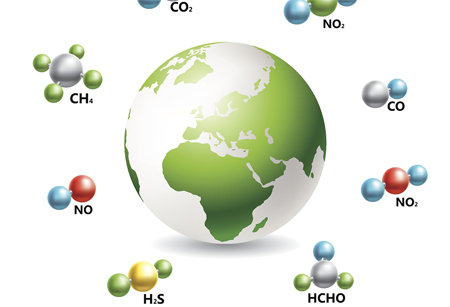A new study conducted by a group of international scientists from China and the UK showed that tropical terrestrial methane (CH
4) emissions explain more than 80 percent of the observed changes in the global atmospheric methane growth rate from 2010 to 2019. The team also for the first time found that sea surface temperature variations could be used to help forecast variations in global atmospheric methane.
The study will be part of an implementation of China's efforts on methane emissions control and reductions in the 2020s, which was included in the China-US Glasgow declaration jointly issued during the COP26 in Glasgow in November 2021, Liu Yi, one of the authors of the study and professor with the Institute of Atmospheric Physics at the Chinese Academy of Sciences, told the Global Times on Wednesday.
Greenhouse gases Photo: VCG
Liu said that CH4 is the primary non-carbon dioxide (CO2) greenhouse gas, and the global warming potential of CH4 is 84 times that of CO2 on a 20-year scale. The emission reduction of methane can help in restraining rapid global warming in a short time.
Methane concentration in the atmosphere has more than doubled since the pre-industrial era, contributing to 20 percent of human-induced global warming. Tropical terrestrial methane emissions, as the main contributor to methane concentration in the atmosphere, represented about 60 percent of the global totals and described 84 percent of the global annual mean growth variation in the 2010s, according to Liu.
Using greenhouse gases observing satellite methane retrievals from 2010 to 2019 and surface measurements from NOAA (National Oceanic and Atmospheric Administration) observations network, scientists found strong seasonal correlations in sea surface temperature anomalies over the tropical oceans and regional variations in methane emissions (via changes in rainfall and temperature) over tropical South America and Africa, Liu said.
For the first time, we find an existing predictive skill for sea surface temperature variations that could be used to help forecast variations in global atmospheric CH4, said first author Liang Feng from the School of GeoSciences at the University of Edinburgh in the UK.
"Currently, there is still an ongoing debate about Chinese methane emissions and its variations. In the future, the team will further use multi-platform observations to report Chinese methane emissions to provide scientific and technological support for China's goal of carbon neutrality," Liu said.
During the 14th Five-Year Plan (2021-25) period, China will promote the implementation of China's methane emission control actions in combination with the formulation and implementation of relevant plans and policies, Lu Xinming, a vice director at the Department of Climate Change of the Ministry of Ecology and Environment, said at a press conference in November 2021, after China and the US announced the signing of the China-US Joint Glasgow Declaration on Enhancing Climate Action in the 2020s.
Lu said China will strengthen the monitoring, accounting, reporting, and verification systems for methane emissions in key areas, promote the collection and analysis of methane emission data in key facilities, and carry out the evaluation and tracking of methane emission reduction effectiveness in key enterprises in major regions to improve the quality of methane emissions data.

